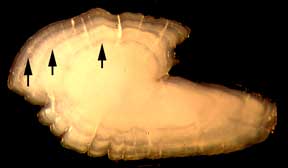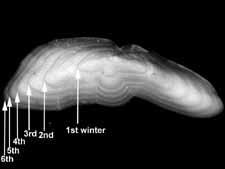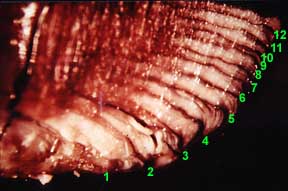Annuli and Age Determination
Scales, bones, fin rays and otoliths have all been used to determine the age of fish, since these and other bony parts of fish often form yearly rings (annuli) like those of a tree. However, otoliths generally provide the most accurate ages, due largely to their continued growth throughout the life of the fish and their acellular nature (which implies that they are not subject to resorption). These features give otoliths a significant advantage over scales and other structures, particularly in old fish. Therefore, otoliths have become the preferred structures for age determinations.
Methods for ageing skates and rays or sharks are analogous, but use vertebrae.
Despite the long-term global use of otolith annuli as age indicators, the factors influencing their formation is not clear cut. Each annulus is comprised of an opaque and translucent zone, which in many species correspond to fast and slow growth respectively. The opposite pattern is apparent in other species. In general though, the opaque zone seems to be formed during periods of increasing water temperatures, while the translucent zone is formed during periods of reduced growth, or in association with spawning.
The preferred method for otolith preparation and interpretation differs among species and age readers. In general however, microscopic examination of whole otoliths (immersed in a clear fluid) is acceptable for thin otoliths, while sectioning or the "crack and burn method" is required for other otoliths. Since otolith length may cease to grow in old fish, even while they continue to thicken, some form of cross section is required of old otoliths. The best papers on otolith preparation and annulus interpretation in temperate and tropical fish otoliths are presented in Chilton and Beamish (1982) and Fowler (1995) respectively. Detailed methods on preparing thin sections are also presented elsewhere in this site.
In keeping with ages derived from otolith microstructure, annular age determinations are an acquired skill, with a significant subjective component. For this reason, age validation is an important component of any ageing study, not only to confirm that the annular rings are visible in the otolith, but that they are being interpreted correctly.
As noted in Quality Control in Ageing consistency between age readers or with other bony structures is not a measure of accuracy. An additional source of error is the correct interpretation of the innermost (first) annulus, for which independent validation is often required.
The Ageing Unit at the Bedford Institute of Oceanography is responsible for ageing between 5,000-10,000 otoliths annually in support of stock assessments for cod, haddock and silver hake (see Production Ageing).
Cod and haddock otoliths are mass-processed: batches of 100 otolith pairs are carefully aligned and embedded in a black polyester resin. Transverse cross sections of the resin block are subsequently cut with a high-speed, water-cooled saw, yielding 100 otolith pair cross sections per plate. After coating with a transparent coating (Krylon Crystal Clear), the plates are dried and aged. All ageing is carried out under an image analysis system. Quality control through the ageing process is rigorous (see Quality Control in Ageing).


